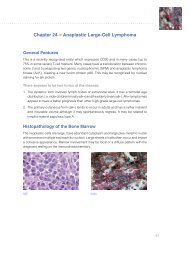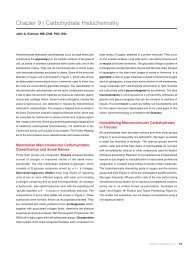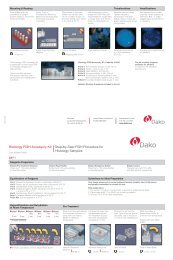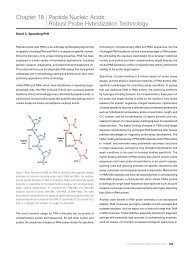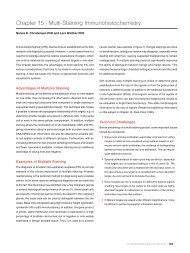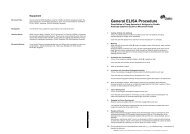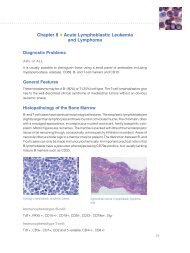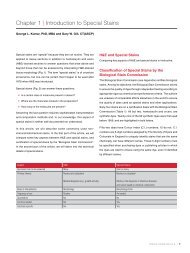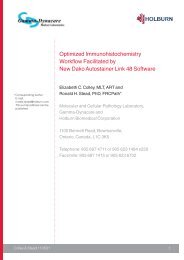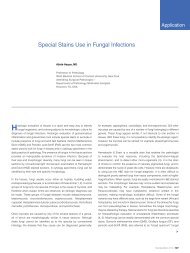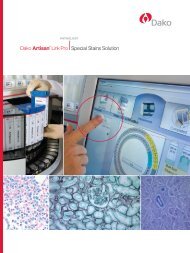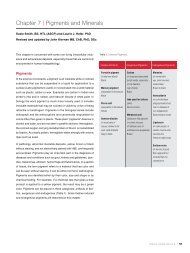ER/PR pharmDx™ Interpretation Manual - Dako
ER/PR pharmDx™ Interpretation Manual - Dako
ER/PR pharmDx™ Interpretation Manual - Dako
Create successful ePaper yourself
Turn your PDF publications into a flip-book with our unique Google optimized e-Paper software.
Quality Control<br />
the first quality control step for interpretation is the<br />
evaluation of the <strong>ER</strong>/<strong>PR</strong> pharmDx tM Control slides. Each<br />
of the supplied control slides contains two pelleted,<br />
formalin-fixed, paraffin-embedded human cell lines: one<br />
positive and one negative with <strong>ER</strong> and <strong>PR</strong> antibodies.<br />
two control slides should be run in each staining<br />
procedure, one incubated with the <strong>ER</strong> antibody cocktail<br />
and one incubated with the <strong>PR</strong> antibody. the evaluation of<br />
the <strong>Dako</strong> supplied control slides indicates the validity of<br />
the staining run. the control slides should not be used to<br />
aid in interpretation of patient results. If either of the con-<br />
trol cell lines have staining results outside the acceptable<br />
criteria, results from all of the test slides stained simulta-<br />
neously within the same run should be considered invalid<br />
and the test should be repeated.<br />
tissue controls should be fresh biopsy/surgical specimens<br />
fixed, processed and embedded as soon as possible in<br />
the same manner as the patient sample(s). Positive tissue<br />
controls are indicative of correctly prepared tissues and<br />
proper staining techniques. one positive tissue control<br />
for each set of test conditions should be included in each<br />
staining run. Endocervix is recommended as a control<br />
tissue that contains both <strong>ER</strong> and <strong>PR</strong> expressing cells.<br />
the specimens used for the positive tissue controls<br />
should give weak positive staining so that subtle changes<br />
in the primary antibody sensitivity can be detected. the<br />
control slides supplied with this system or specimens<br />
processed differently from the patient sample(s) validate<br />
reagent performance only and do not verify tissue<br />
preparation.<br />
Known positive tissue controls should only be utilized<br />
for monitoring the correct performance of processed<br />
tissues and test reagents, not as an aid in formulating a<br />
specific diagnosis of patient samples. If the positive tissue<br />
controls fail to demonstrate appropriate positive staining,<br />
results with the test specimens should be considered<br />
invalid and the test should be repeated.<br />
Use a negative control tissue (known to be <strong>ER</strong> and <strong>PR</strong><br />
negative) fixed, processed and embedded in the same<br />
manner as the patient sample(s) with each staining<br />
run to verify the specificity of the primary antibody and<br />
to indicate unintended cross-reactivity to cells/cellular<br />
components. the variety of different cell types present in<br />
most tissue sections offers internal negative control sites.<br />
If specific staining occurs in the negative control tissue,<br />
results with the patient specimens should be considered<br />
invalid and the test should be repeated.<br />
<strong>ER</strong>/<strong>PR</strong> pharmDx <strong>Interpretation</strong> <strong>Manual</strong><br />
QUAlIty ContRol<br />
11



